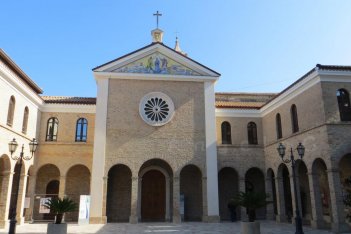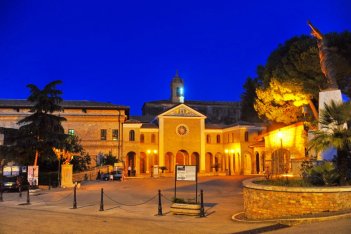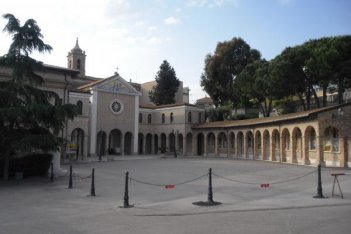- Home
- Punti di interesse
- Il Santuario della Madonna dello Splendore
Descrizione
Il Santuario della Madonna dello Splendore sorge sulla collina della
città, sulla sommità a Nord, ed è uno dei luoghi mariani più noti del
Centro e Sud Italia.
La cronaca seicentesca del monaco Pietro Capullo fa risalire l’origine
del santuario al 22 aprile 1557, confondendo la data incisa sulle arcate
d’ingresso con quella del miracolo. Di fondazione più remota,
collocabile tra la fine del Quattrocento e gli inizi del secolo
successivo, in contemporanea alla costruzione di Giulia, il santuario
dello Splendore nasce a seguito dell’apparizione della Madonna
circondata di luce su un olmo ad un umile contadino di nome Bertolino;
nella sua ultima apparizione la Vergine, comparendo a tutto il popolo
giunto sulla collina, fece sgorgare dai piedi dell’albero una sorgente
di acqua, tuttora attiva e ritenuta miracolosa, oggi in corrispondenza
dell’altare maggiore.
Da almeno quattro secoli, il 22 aprile di ogni anno, Giulianova ricorda l’apparizione con solenni festeggiamenti.
Il santuario è stato retto per secoli dai padri celestini e, dal 1847,
dai francescani cappuccini che eressero la torre campanaria. Divenuta
priorato, la chiesa venne ampliata nel Seicento per volontà dei duchi
Acquaviva devoti alla Vergine dello Splendore. Oggi la chiesa si
presenta secondo le modifiche che ne interessarono l’intera struttura
dal 1937 al 1959.
- Patrimonio artistico:
Sull’altare maggiore si conserva in una raggiera la venerata statua della Madonna dello Splendore, opera lignea del XV secolo.
L’interno è decorato dalle pitture di Alfonso Tentarelli con storie
della Vergine e dell’apparizione risalenti ai lavori novecenteschi.
Nella sagrestia, accanto all’altare, è possibile ammirare una grande tela cinquecentesca di Paolo Veronese, raffigurante l’Incoronazione della Vergine con i santi, e un prezioso tabernacolo ligneo con inserti in avorio e madreperla del Seicento, prezioso esempio del lavoro dei frati maestri ebanisti detti “marangoni”. Passando nel coro, si ammirano quattro tele del pittore Giacomo Farelli, commissionate dai duchi Acquaviva nel Seicento: l’Annunciazione, la Natività, l’Assunzione e l’Immacolata.
All’esterno della chiesa, il complesso del santuario si è arricchito a
partire dal 1986 di molti interventi. La via che scende verso il Lido è
stata trasformata in una grande Via Crucis: ogni stazione ospita un gruppo bronzeo dello scultore Ubaldo Ferretti, allievo di Pericle Fazzini. Nel chiostro è stato ripristinato il locale, ornato di mosaici, con le fontane e la vasca per immergere gli infermi. Ancora nel chiostro, è possibile visitare la biblioteca dedicata alla storia e alla cultura abruzzesi.
-- ENG --
Description
The sacred place “Madonna dello Splendore” up on the hill of the city, facing north, and one of the most famous Marian churches in central and southern Italy.
The 17th century chronicle of the monk Pietro Capullo traces the origin of the sacred place back to 22 April 1557, confusing the date engraved on the entrance arches with that of the miracle. On ancient foundations, which date back to the end of the 15th century and the beginning of the following century, the sacred place "dello Splendore" was built at the same time as Giulia was founded, after that, that the Virgin Mary appeared surrounded by light on an elm tree to the humble peasant Bertolini; in her last apparition the Virgin, appearing to all the people who had arrived on the hill, caused a spring of water to flow from the foot of the tree, still active and considered miraculous, today in correspondence with the main altar.
For at least four centuries, Giulianova has commemorated the apparition with celebrations on April 22 each year.
The sanctuary has been guarded for centuries by the Celestines and, since 1847, by the Francicans Capuchin who erected the bell tower. Having become a priory, the church was enlarged in the seventeenth century by the will of the Acquaviva dukes devoted to the Virgin of Splendor. After the last changes from 1937 to 1959, the church presents itself in its current structure.
Artistic heritage:
The venerated statue of the Madonna dello Splendore, a wooden work from the 15th century, is placed at the main altar.
The interior of the church is decorated with 20th century paintings by Alfonso Tentarelli depicting stories about the Virgin and her apparition.
In the sacristy, next to the altar, you can admire a huge painting by Paolo Veronese from thre 16th depicting the Coronation of the Virgin Mary with the Saints, as well as a precious 17th century wooden tabernacle with ivory and mother of pearl inserts, a valuable example for the work of the monks as master carpenters, also called "Marangoni". Passing through the choir walk, you can admire four paintings by Giacomo Farelli, commissioned by the Acquaviva dukes in the 17th century: the Annunciation, the Nativity, the Assumption and the Immaculate Conception.
Outside the church, the holy place has undergone many changes since 1986. The way that goes down to the seaside has been transformed into a huge “Via Crucis”: each station shows a bronze group by the sculptor Ubaldo Ferretti, a student of Pericle Fazzini. In the cloister, a room decorated with mosaics has been restored, with a fountain and a tub for bathing the sick.
Following the cloister you can visit the library dedicated to the history and culture of Abruzzo.
-- DE --
Beschreibung
Die heilige Stätte „Madonna dello Splendore“ steht auf dem Hügel der Stadt, Richtung Norden, und ist eine der bekanntesten Marienkirchen Mittel- und Süditaliens.
Die Chronik des Mönches Pietro Capullo aus dem 17. Jahrhundert führt den Ursprung der heiligen Stätte auf den 22. April 1557 zurück und verwechselt das auf den Eingangsbögen eingravierte Datum mit dem des Wunders. Auf alten Fundamenten, welche aus dem Ende des fünfzehnten und dem Beginn des folgenden Jahrhunderts stammen, wurde zeitgleich mit der Gründung von Giulia, die heilige Stätte „dello Splendore“, nachdem dem bescheidenen Bauern Bertolini die Jungfrau Maria vom Licht umgeben auf einer Ulme erschienen ist, gegründet; bei ihrer letzten Erscheinung ließ die Jungfrau, die dem Volk erschien, das auf dem Hügel angekommen war, eine Wasserquelle am Fuße des Baumes entspringen, die noch heute an der Stelle des Hauptaltares fließt und als Wunder gilt.
Seit mindestens vier Jahrhunderten erinnert Giulianova jedes Jahr am 22. April mit Feierlichkeiten an die Erscheinung.
Der heilige Stätte wurde seit Jahrhunderten von den Zölestinern und seit 1847 von den Franziskanerkapuzinern, die den Glockenturm errichteten, gehütet. Nachdem die heilige Stätte Priorat wurde, ist die Kirche im 17. Jahrhundert durch den Willen der Herzöge Acquaviva, die die Jungfrau „dello Spelendore“ anbeteten, erweitert worden. Nach den letzten Veränderungen von 1937 bis 1959 präsentiert sich die Kirche in ihrer heutigen Struktur.
Künstlerisches Erbe:
Die verehrte Statue der „Madonna dello Splendore“, eine Holzarbeit aus dem 15. Jahrhundert, ist am Hauptaltar aufgestellt.
Das Innere der Kirche ist mit Gemälden von Alfonso Tentarelli, welche Geschichten über die Jungfrau und ihre Erscheinung darstellen, aus dem 20. Jahrhundert geschmückt.
In der Sakristei neben dem Altar kann man ein großes Gemälde von Paolo Veronese aus dem 16. Jahrhundert bewundern, das die Krönung der Jungfrau Maria mit den Heiligen darstellt, sowie einen kostbaren hölzernen Tabernakel aus dem 17. Jahrhundert mit Elfenbein und Perlmutt Einsätzen, ein wertvolles Beispiel für die Arbeit der Mönche als Tischlermeister, die auch „Marangoni“ genannt werden. Wenn Sie durch den Chorstuhl gehen, können Sie vier Gemälde des Malers Giacomo Farelli bewundern, die im 17. Jahrhundert von den Herzögen Acquaviva in Auftrag gegeben wurden: die Verkündigung, die Geburt, die Himmelfahrt und die Unbefleckte Empfängnis.
Außerhalb der Kirche wurde die heilige Stätte seit 1986 durch viele Veränderungen bereichert. Die Straße, die zum Meer hinabführt, wurde in eine große Via Crucis umgewandelt: Jede Station zeigt eine Bronzegruppe des Bildhauers Ubaldo Ferretti, Schüler von Pericle Fazzini. Im Kreuzgang wurde ein Raum, mit Mosaiken geschmückt, mit Brunnen und einer Wanne zum Eintauchen der Kranken restauriert. An den Kreugang anschliessend kann man die der Geschichte und Kultur der Abruzzen gewidmete Bibliothek besuchen.



